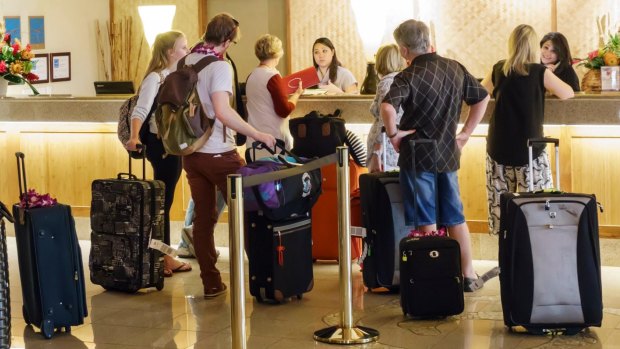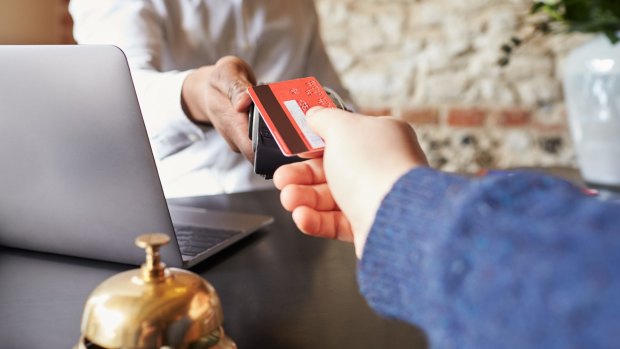This was published 4 years ago
Should you pay in your own currency with credit cards overseas? Why it's a rip-off

One of the most common spots for this rip-off is when checking out of a hotel.Credit: Alamy
It's a trick that catches out even the most experienced travellers. I've made this mistake. I'm sure many other people have as well.
You're settling your hotel bill overseas, or you're finishing your meal at a restaurant, or you're about to buy some clothes at a shop, and you decide to pay by credit or debit card. You tap your card on the machine, or maybe insert the chip. You enter your PIN. And then you get a little prompt on the screen: "Would you like to pay in your own currency?"
Instinctively, you think: yes. Of course you would. It feels cheaper to pay for something in your own currency. It feels like you're dodging a conversion, like you're actually getting rid of a step and will save money in the process.

Paying in your own currency sounds good, but don't be fooled.Credit: Shutterstock
The truth is the opposite. If you choose to pay in your own currency, you'll be paying more than you should – probably somewhere in the range of 7 to 8 per cent more. That means, for example, that if you have a $450 hotel bill, you'll end up paying $486, or $36 more than you otherwise should have.
It's a total rip-off, and here's how it works.
Whenever you select "yes" to that innocuous question, you're not avoiding a currency exchange – you're leaving it in the hands of the institution that's processing the card payment.
This whole scheme is cheeky at best, and an outrageous scam at worst.
That institution can set the exchange rate at whatever it likes. And while, yes, it's true that when you're prompted with the question of currency you'll also be shown how much you'll be charged in Australian dollars, most people can't do a complex exchange calculation in their heads, which means you'll barely glance at the number before hitting the button and confirming the transaction.
The people handling the card payment know this, of course, which is why they can get away with offering travellers a shocking exchange rate and relying on them to still accept it. Sometimes there's even an extra conversion fee changed on top of your crappy exchange, a windfall that's decided and split between the merchant (the restaurant, the shop, the hotel) and the financial institution.
Some EFTPOS terminals I've recently used have also added an extra level to the process, asking, after you've hit the "no" button, something along the lines of: "Are you sure? If you choose to pay in local currency, the exchange rate will be set by your bank or financial institution."
That gives you pause again. It makes you think, wait, maybe I do want to pay in my own currency? What if my bank overcharges me?
And then you'll find some wait staff, as well as those working in shops and hotels, have been trained to guide you towards hitting that "yes" button, given the place they work at gets a cut of this juicy rip-off. Some will even make the selection for you, ostensibly as part of the service, so it's certainly worth checking before you sign or push "enter" on any transaction.
It's annoying to have to worry about this. This whole scheme is cheeky at best, and an outrageous scam at worst – and it's one being perpetrated by the institutions travellers tend to trust, hotel chains and high-end restaurants and the like.
Unfortunately there's not a lot you can do about it, except to remain vigilant. These "dynamic currency conversion" charges are perfectly legal, and the entire transaction is shown to you before you commit to the sale.
The trick is to be aware, and to make the avoidance of these charges part of a larger strategy to manage your money effectively when you're overseas.
That strategy should involve looking for a bank or other financial institution in Australia that waives foreign transaction fees and foreign ATM fees – there are a few. You could also consider using a pre-paid travel card that allows you to load up with foreign currencies, meaning you'll have no option to pay in "your own" currency.
Another tactic is to stick to using cash wherever possible while you're travelling. In countries where you feel safe doing so, that means taking out large amounts of money each time you go to the ATM, to avoid extra transaction or exchange fees where present, and to allow you to pay for most things without another exchange.
And, of course, the final thing to remember: always choose to pay in local currency when you use a credit or debit card. Never pay in your own. Just like that, you've saved a huge amount on your travel bill.
Have you made the mistake of paying in "your own currency" while travelling overseas? Do you think hotels and other institutions should be more upfront about the costs you'll incur?
Email: b.groundwater@traveller.com.au
Instagram: instagram.com/bengroundwater
See also: The truth about hotel 'holding charges' on your credit card
Sign up for the Traveller newsletter
The latest travel news, tips and inspiration delivered to your inbox. Sign up now.